July 27, 2018 - total lunar eclipse and the great opposition of Mars
In modern times, the prevalence of fake information about the most simple and clear astronomical phenomena is literally threatening. This article is written with the aim of increasing the specific amount of truthful information on the Internet, good, there is a wonderful reason for this.
On the night of July 27-28, 2018 two rather rare astronomical phenomena will occur. The fact of their calendar coincidence does not make these phenomena more valuable for science, but creates additional interest around them. Some people consider the coincidence of two astronomical phenomena as a certain independent phenomenon, which is not quite correct, but deserves separate consideration from the point of view of understanding how often this happens, and whether the one affects the other in any way.
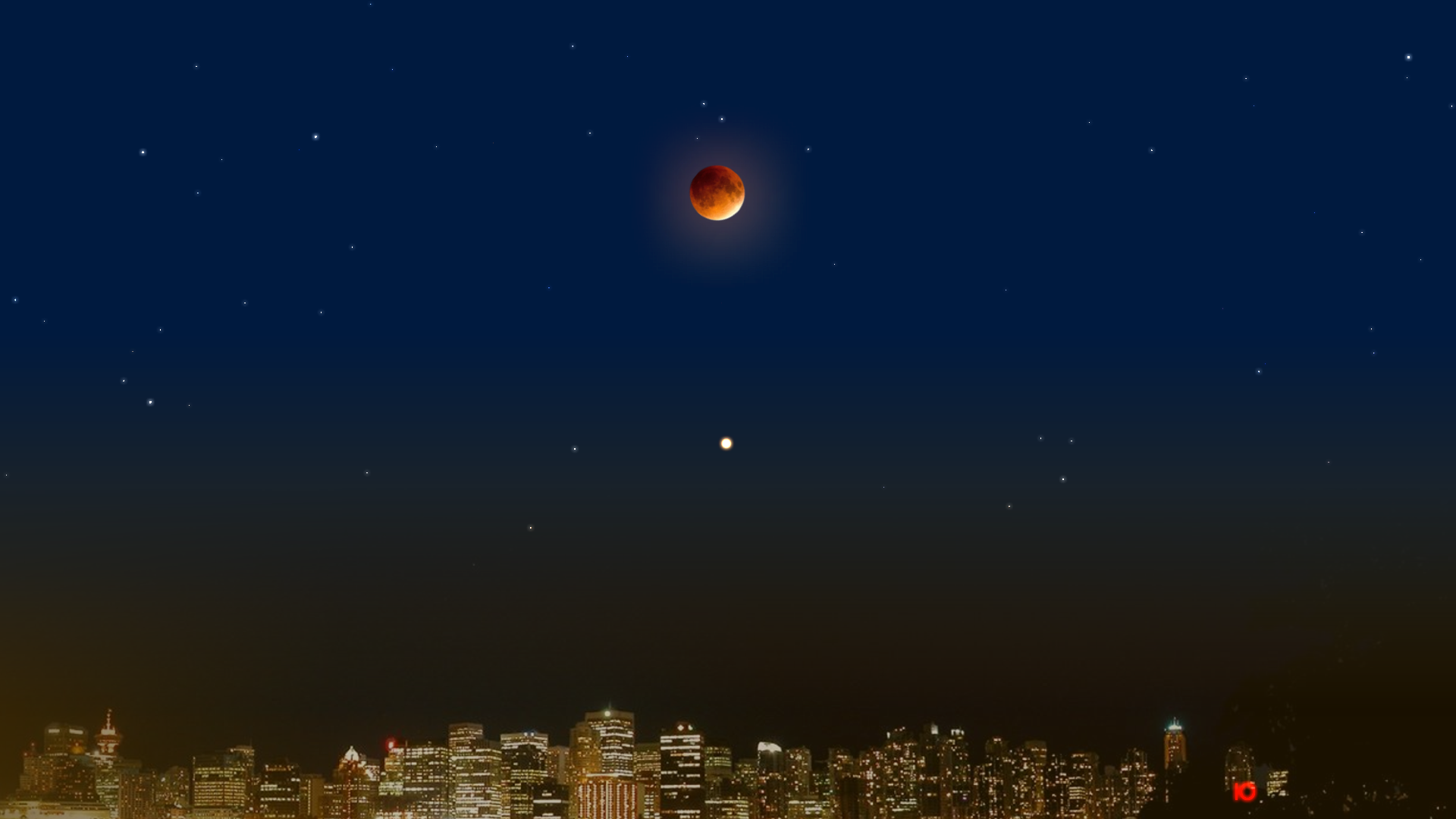
')
On July 27, at about 7 am Moscow time, the great opposition of Mars will occur. Similar phenomena occur once every 15 or 17 years. The previous great confrontation took place on August 27, 2003, and since that time the virus fiction has been roaming the Internet, which has become more acute in August:
For 15 years, the epidemic has not subsided. As you can see, the great oppositions of Mars have a significant impact on ignorant minds.

On July 27, at around 8 pm, the half-shadow phases of a lunar eclipse will begin, during which the moon will completely plunge into the earth's shadow (the maximum immersion will occur at 23:22 Moscow time). Eclipse will end at 2 hours 29 minutes - already July 28. The phenomenon will last more than 6 hours. The moment of the great opposition of Mars, as we see, does not fall into the duration of the eclipse. But the temporary difference between the moment of opposition and the central phase of the eclipse is less than a day. Let it be a match criterion. It is quite enough that both events will occur (or at least begin) on the same calendar date.
For a start, let's deal with the essence of the phenomena themselves. What they are, what visual image corresponds to them, what physical or astronomical sense they have.
Wikipedia gives the following definition of the term “Confrontation”:
This is exactly the case when the definition of a concept can lead to even more confusing, since it uses terms that require further clarification.
Ecliptic longitude:
As we see, each following definition requires new definitions. And for a person who does not have the entire base of the basic concepts of astronomy, even the simplest astronomical phenomenon - the confrontation of Mars - can be very vague to understand.
Then maybe we will try to understand the essence of what is happening in some other, shorter way?
In the first approximation, the orbits of the planets are circles of different diameters. This degree of approximation doesn’t suit us very well, especially when the conversation concerns the planet Mars, but to start it will be enough. The orbits are located one inside the other concentrically. In the middle of this “drawing” is the Sun, and then in order of increasing the radius of the orbit - the planets: Mercury, Venus, Earth, Mars, Jupiter, Saturn, Uranus and Neptune. Pluto, if someone missed, since 2006, the big planet of the solar system is no longer considered.
Two planets from this list - Mercury and Venus - are internal. They are always closer to the Sun than the Earth (their orbits are located inside the Earth's orbit). The remaining five - Mars, Jupiter, Saturn, Uranus and Neptune - are external. They are always farther from the sun than the earth. And for these celestial bodies such situations are possible when the Earth, moving in an orbit, passes between the planet and the Sun. When viewed from Earth, the Sun and the planet turn out to be practically in opposite directions. The first consequence of this is that for a terrestrial observer, this planet and the Sun are not visible in the sky at the same time, and as soon as one star rises above the horizon, another immediately sets.
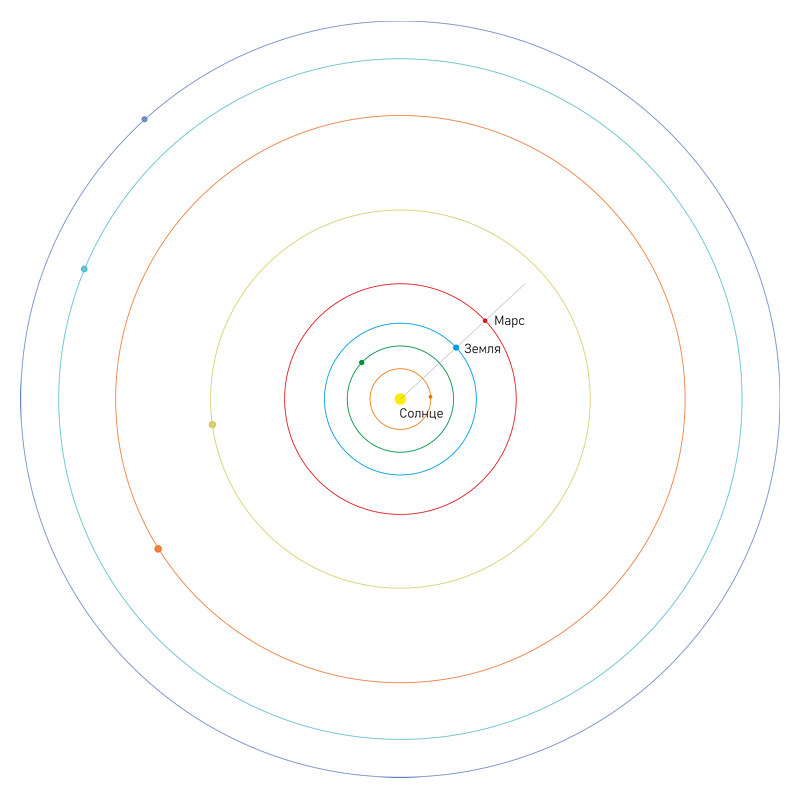
This arrangement of the outer planet is called opposition - the direction to it from the Earth is opposite to the direction to the Sun. The planet is in the sky all night. For her observations such a position is convenient.
The second consequence is that at the moment of confrontation (again, in the first approximation), the planet is closest to Earth. Because of this, it looks brighter (brightness, as is well known, is inversely proportional to the square of the distance), has large visible dimensions (with a telescope, of course, but this is not noticeable to our eyes). And this is also a positive circumstance for astronomical observations. Therefore, the confrontation of the planets is the best time to explore them from Earth. Astronomers have long tried to use days and weeks close to opposition to explore planets. People who have no relation to astronomy most often simply marvel at the appearance in the sky of star-shaped luminaries of extraordinary brightness, which they had not noticed before in the sky.
Now is the time to remember that in fact the orbits of the planets are not circles. About four centuries ago, Johann Kepler defined planetary orbits with ellipses. Orbits of some orbits are noticeably different from circular ones. Mars is particularly relevant. The value characterizing the elongation (difference from the circle) of an elliptical orbit in astronomy (and mathematics) is called eccentricity. Without going into the deep meaning of this concept, I will simply cite for comparison the eccentricities of the orbits of the planets of the solar system visible to the eye:
An absolutely circular orbit has an eccentricity of zero. Those in the table there. The most significant eccentricity among the orbits of the major planets of the solar system, the orbit of Mercury - 0.2. But Mercury is an inner planet, and there is no opposition to Mercury. The second place in elongation is Mars orbit ~ 0.1. This is 6 times the eccentricity of the Earth's orbit, and we can easily consider the Earth's orbit as circular - to simplify the understanding of the difference in the mutual arrangements of Earth and Mars.
Such a noticeable elongation of the Martian orbit leads to the fact that in one Martian year (the period of Mars’s orbit around the Sun is about two Earth years), the distance from Mars to the Sun varies from 207 to 249 million km. As you can see, the difference, even on the cosmic scale of the solar system is noticeable - more than 40 million kilometers. Approximately with the same difference, the distances from Earth to Mars change during the confrontations. And if the opposition happens near the perihelion of the Martian orbit (perihelion is the nearest point of the planetary orbit to the Sun), then Mars and Earth are separated by less than 60 million kilometers. If the Earth and Mars are on the same straight line on one side of the Sun near the aphelion of the Martian orbit, then, despite the fact that this opposition, between the planets will be about a hundred million kilometers. Agree that 60 or 100 million is a huge difference for astronomical observations.
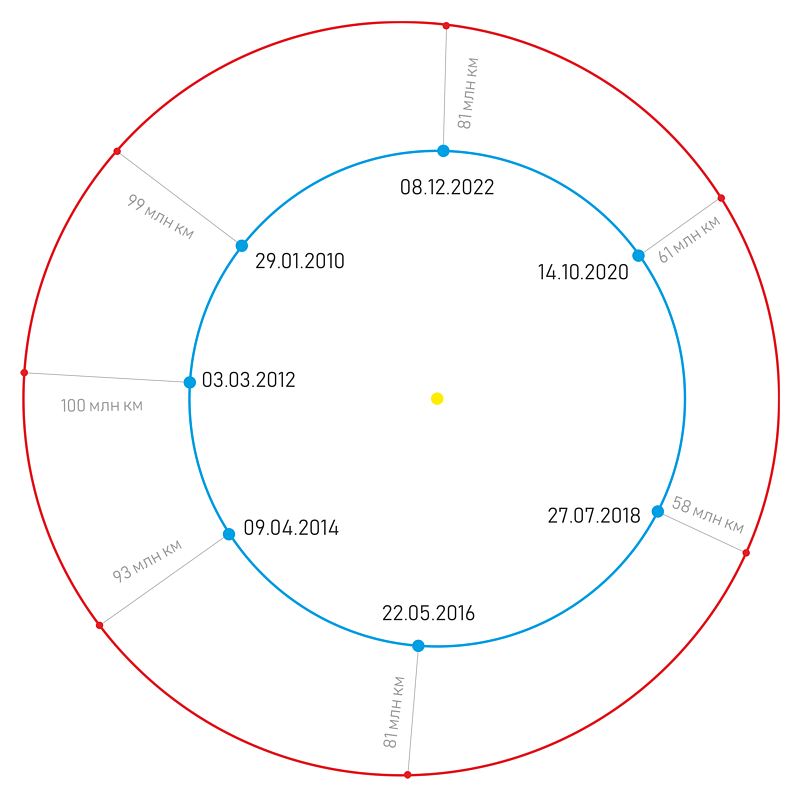
And indeed, all the most significant discoveries in astronomy related to the planet Mars, made with the help of telescopes, occurred during the "close" confrontations. And astronomers began to call the opposition, during which Mars and Earth are closer than 60 million kilometers from each other, great.


It was during the great confrontation of 1877 by the American astronomer Asaf Hall that two Mars satellites were discovered - Phobos and Deimos, which are essentially small asteroids of irregular shape, once gravitationally captured by Mars (according to one of the hypotheses); and the beginning of the so-called "Martian Fever", when Giovanni Schiaparelli saw, among other details of the surface of the planet, thin straight lines connecting the dark, called "seas", space. And although the existence of “Martian canals” was not confirmed later, every great opposition of Mars attracted astronomers to the telescope eyepieces, and science fiction writers tirelessly wrote thousands of pages, embodying their wildest assumptions about possible life on a planet similar to Earth.
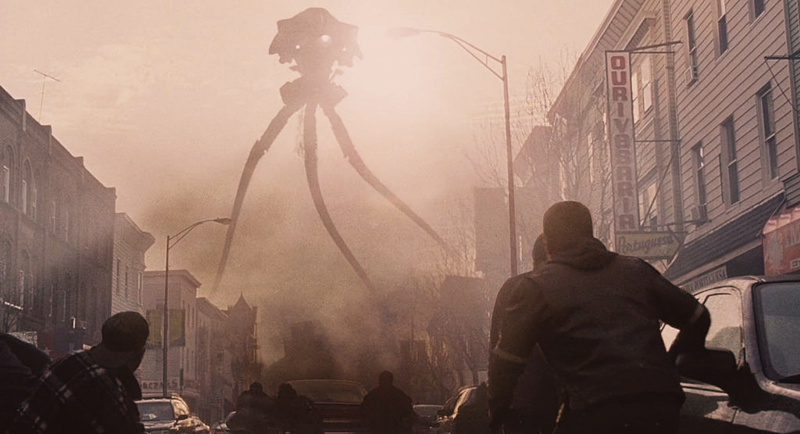
Let us consider the conditions under which the Great confrontations occur. To do this, we need an acquaintance with another important astronomical value - heliocentric longitude. If you look at the solar system from its north pole (and it also has it, but we will not define this concept now - perhaps we will be able to deal with it and other astrometric terms in the next article). We will again see the concentric structure of the planetary orbits. Each planet is somehow located in its own orbit. The orbit itself is also somehow oriented in space. But we do not yet have a “point of support” in order to cling to something, and then count the coordinates in some units and determine the positions of the planets in such a simple drawing.
Historically, the reference point was the direction of the vernal equinox. See, the ray leaving the center of the Earth in the direction of the Sun at that moment, when on Earth the day is equal to night and the (astronomical) spring comes - this ray goes somewhere in the direction of the constellation Pisces. In fact, in the direction of that line, which is the intersection of the plane of the ecliptic and the celestial equator, but omit these details. It is important to us that the direction is somehow determined. Now, but relying on the center of the Sun, we can lay the angles between this and all other directions on the plane of our simplified scheme of the Solar System.
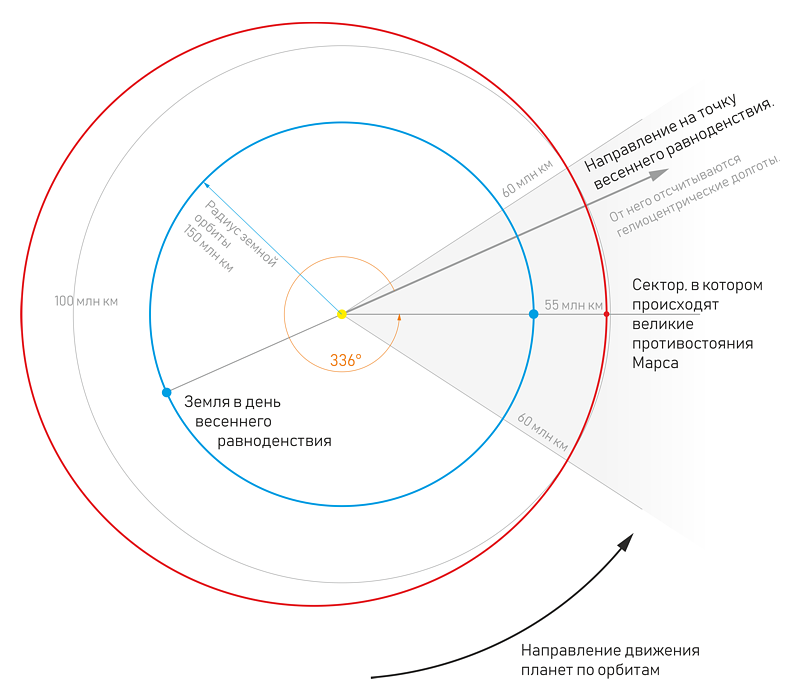
For example, we can measure how different are the directions to the vernal equinox and the point of the Martian orbit where it is closest to the Sun? - it turns out, at 336 degrees (in the counterclockwise direction, in which all the planets move around the Sun). This value is called the longitude of the perihelion. It is interesting to know on what day each year the Earth passes this point (with the same heliocentric longitude) of the orbit, above which the perihelion of Mars is located? After all, if a confrontation ever happens on that day, it will be a record close.
A happy “Martian day” falls on the very end of August - on August 28 or 29, depending on the year. Here is the time to recall the previous great opposition of Mars in 2003, which happened exactly on the aforementioned days of August (practically), and for its exclusivity, it was called the “greatest” opposition of Mars. Yes - nowadays simply you will not surprise anyone with the great opposition of Mars. But, really, then the Earth and Mars were separated by only 55.8 million km.
And what about the current great opposition? It is, alas, not so close and it could even be called “too big”, since the distance between Earth and Mars on July 27, 2018, and the days nearest to this date, will be 58 million kilometers, which is closer to the threshold, beyond which confrontations are no longer considered great, rather than to the “Greatest” confrontations.
Now it is interesting to recall one interesting clarification, which is expressed in the fact that if during the greatest confrontation of Mars, the day of confrontation and the day of maximum convergence of the Earth and Mars actually coincide, then for most of the other confrontations this is not the case. For example, this year the opposition of Mars, when in the celestial sphere it will confront the Sun, will happen on the morning of July 27, but due to the ellipticity of the orbit, Mars will be closest to Earth on the night of July 31 to August 1.
The second interesting clarification is that the position of the perihelion of the Martian orbit changes with time. For a thousand years, the angle between the direction of the vernal equinox and the perihelion of Mars increases by more than 4 degrees. And that period on the calendar grid, in which great confrontations can happen, will shift 4 days ahead in a thousand years.
Now great confrontations can occur between July 24 and October 2. In the future, these dates will change slightly. In the past, they were also slightly different. Although it is not so important now.
Since the criterion by which Mars’s oppositions are defined as “great” is very conditional, it’s difficult to talk about some unequivocal calculation of these events at a considerable distance from the present moment into the past or the future. Simply put, the great oppositions of Mars occur every 15 or 17 years with a rather confusing alternation of time intervals separating them. As an example, confrontations from a century and a half ago in the present era can be cited:
Such tables can be easily found on dozens or hundreds of sites on the Internet. But then the interesting begins. The confrontation of July 13, 2065 is formally a little short of a great one, since at the very moment of the confrontation Mars and Earth will be separated by a distance of 60.191 million km - it would seem - a trifle, and does not pass under the criterion. But - on the evening of July 18 - having already passed the confrontation - Mars will come closer to Earth to 59.790 million km. And here it is already difficult for him to deny greatness, since all the days surrounding the confrontation itself are considered an era of confrontation. Two years later, another great confrontation will happen - on October 3, 2067, when Mars will be just a little closer, but also completely below the bar - 59.94 million km at the time of opposition, and - 59.34 million km with maximum convergence five days earlier. And no one knows how the astronomical public will relate to the classification of these phenomena in almost half a century from today. Moreover, if we consider the opposition carefully, it is clear that the sum of the distances separating the Earth and Mars (60.19 + 59.94 = 120.13) exceeds 120 million kilometers for two, which means that it is theoretically possible that after 15 years no great confrontation will happen in the next two years, judging them strictly. And then another 15 years Mars will be objectively far to correct this state of affairs.
It may have arisen, but did not fall into the attention of astronomers of past centuries, since the phenomenon itself - “the great opposition of Mars” - was introduced only when it became possible to accurately determine the distances to the planets, that is, relatively recently.
Why, in some confrontations, Mars shines with a surprisingly bright luminary, and in others - only an ordinary reddish "star" - neither ancient astronomers, nor contemporaries of Galileo - did not know this. And even in the era of the invention of the telescope, among serious astronomers there were many supporters of the theories about crystal spheres and ideal circles instead of elliptic orbits.
First of all, the brightness of the planet is very different. Between the oppositions, when Mars is lost in the evening or morning dawn, its brilliance is comparable to the brightness of one of the stars of the Ursa dipper and no one pays attention to it. During distant confrontations, when the Earth and Mars are separated by hundreds of millions of kilometers, Mars is noticeably brighter, and already successfully competes with the brightest stars of the sky. His characteristic magnitude is -1m. That is, it is brighter than most stars, but weaker than Sirius (Big Dog's alpha is the brightest star in the sky). But during the great confrontation, Mas's brilliance reaches -2.9m, and then Mars becomes the brightest star of the earth after the Sun, the Moon and Venus. And if you consider that neither the Sun nor Venus does not shine at night, then during the great opposition of Mars only the Moon can shine brighter in the sky than it. But even under the Moon, Mars draws its attention with its distinctly red hue completely uncompromisingly, since none of the bright stars have such a saturated red color ... Is the Moon in eclipse ...

And here we remember that the upcoming July 27, 2018 great opposition of Mars will occur on the same date with a total lunar eclipse - no less outstanding than the opposition of Mars.
Even 10 years ago, it seemed to me that it was not necessary to explain the nature of such phenomena, and they all more or less clearly imagine what caused the eclipses to happen - that celestial bodies cast shadows. And either an observer (a case characteristic of a solar eclipse) or another celestial body (this is just a lunar eclipse) can fall into the shadow of a celestial body. I understand that among the readers of this article such basics are probably known, but it is necessary to at least briefly designate them, because from these elementary points there are consequences, questions, interesting details.
It is not difficult to guess that lunar eclipses — phenomena of transit of the moon through the earth's shadow — occur only when the moon in the sky is opposite to the sun, that is, on a full moon. At the same time, not every full moon is accompanied by a lunar eclipse. The lunar orbit lies in a plane different from that of the earth’s orbit, and most often the moon passes under a shadow or above a shadow. And the shadow falls on average a couple of times a year. And this is not necessarily exactly when it is above the horizon. Quite often it happens that the moon eclipse happens when we have all day long. Or - in bad weather. So, to get on this heavenly show - a rare luck and great honor for any person interested in astronomy - to see how slowly the Moon disappears in a dark roundish shroud, how it is littered, acquiring a deep red tint completely unusual for it, how its night shine fades, yielding to the radiance of the stars and the Milky Way ... how everything returns back, leaving only amazing sensations of belonging to something rare and special. It is not surprising that our ancient ancestors gave eclipses such a significant meaning, not always corresponding to their true nature, but always emphasizing the originality of the event.
As you might guess, there are only two points in the lunar orbit, next to which the moon can "meet" with the shadow of the Earth - these are the so-called lunar nodes. And it may seem that in the year there are two calendar dates, near which eclipses can occur. But in fact, the lunar nodes do not stand still and slowly turn, "running" all the ecliptic for 19 years. To this are added light rocking - changing the angle of inclination of the lunar orbit with respect to the Earth. In combination of the described and many other factors lies the non-triviality of predicting the moments and circumstances of lunar eclipses, which, at least in terms of visual characteristics, are quite different.

The moon is four times smaller than the Earth, therefore, it should fit in the earth's shadow. But then the Earth is smaller than the Sun, and therefore it casts a converging cone of shadow into space. At a distance of a few more than a million kilometers from Earth, the earth’s shadow is finally fading away. But since the Moon is at an average distance of 384 thousand km from the Earth, it is quite able to plunge into the shadow, and at such a distance the cross section of the shadow is more than twice the diameter of the Moon.
The Earth casts in the direction opposite to the Sun not only a conically decreasing shadow, but also a conically expanding penumbra. If the observer is in the penumbra, then he sees the solar disk, slightly obscured by the body of the Earth - an analogue of a partial solar eclipse, which occur on the Earth due to a similar "fault" of the Moon.
And any shadow lunar eclipse is preceded by a half-shadow phase - to get to the earth's shadow, the moon will have to overcome half-shadow and darken a little in it. But the fall in the brightness of the lunar disk, crossing the Earth's partial shade, is almost imperceptible to the eye.
If the full moon comes at some distance from the node of the lunar orbit, the moon can pass by the shadow, but fall into penumbra. Such eclipses are called penumbral. As a rule, they do not receive the attention of a public who is far from science. Even lovers of astronomy do not attach much importance to them. But if the Moon is even a little bit in the shadow, then this is already a shadow eclipse, and everyone who has such an opportunity is watching it. And again, the moon may not fully sink into the shadow, and soon leave it. Then it is a private shadow lunar eclipse.
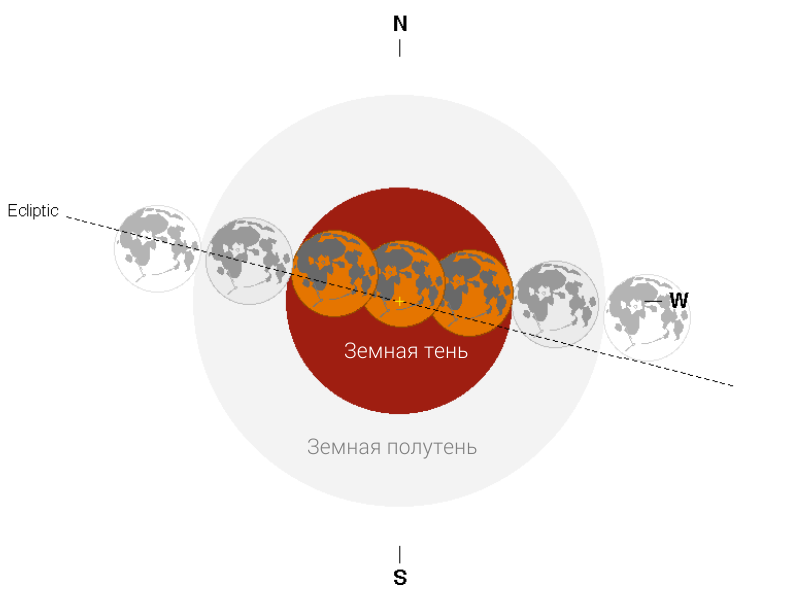
The upcoming eclipse is a complete one. Moreover, it is almost central. The center of the moon will pass less than a quarter of a degree to the north (above) of the center of the earth's shadow, but at the same time the southern continental part of the lunar disk, having a maximum brightness outside the eclipse, will fall into the center of the shadow. Because of this, a general drop in the brightness of the moon will be the maximum possible (other things being equal). The upcoming lunar eclipse will turn out to be one of the darkest eclipses, which undoubtedly makes it unique, and for science its observation can bring a lot of useful data about the Earth's atmosphere.

During total lunar eclipses - even the darkest - the moon does not disappear in the sky at all. But its appearance is changing. Instead of a bright white-yellow disk shining in the night, only dark-red remains in the sky - sometimes, barely noticeable - an obscure ghost of the Moon. How does sunlight reach the moon if it is completely submerged in the earth's shadow?

During an eclipse, the Moon is shielded by the body of the Earth only from direct sunlight, but not from refracted and scattered by the Earth's atmosphere. Of the entire spectrum of visible rays of the moon, only the longest wavelengths — red and orange rays — reach. The rest are absorbed by the earth's atmosphere. By conducting photometric and spectral observations of the eclipsed moon, astronomers can get quite a lot of information about the processes occurring in the Earth’s atmosphere. , , , , — , , .
, ( — ) : , () . , 27 — — , . ( , — , — .) 6 . , 58 , .
, , . , — 15 — 17 . , ?
, . — — ? . — — .
, , , . , , — 15 17 . — 32 . — “ ” ~ 19 . 608 . , , . , , . , , . — , — — 27 2018 .
, .
«» , . . , .
, , ISO. , . ISO , , , . ISO 100. , , ISO 200, 400, 800 . , , .
10 — , , , , . , , , . — , . , — . , . , . « ».
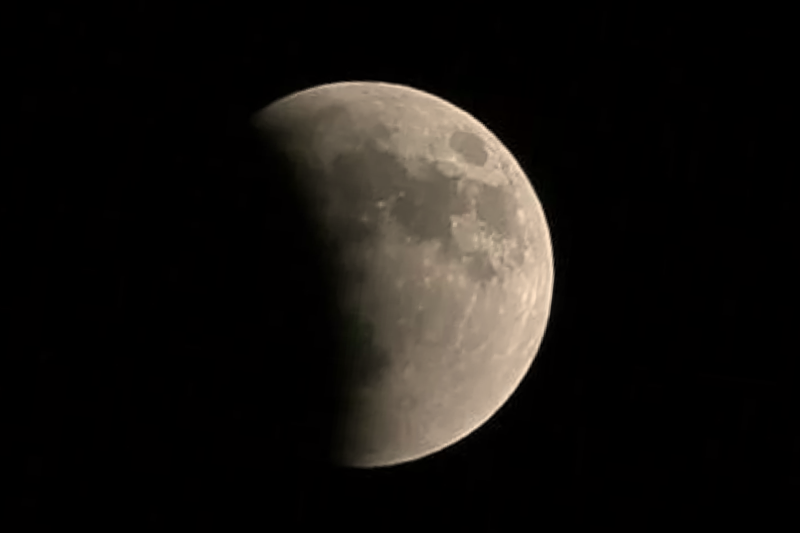
, ISO 100 10 1/100 . , , , 1/160 — 1/200 . 27 28 . 15 . , 1/100 — 1/60. . , . , , 2- , .
, . , ( — ), , — , , .
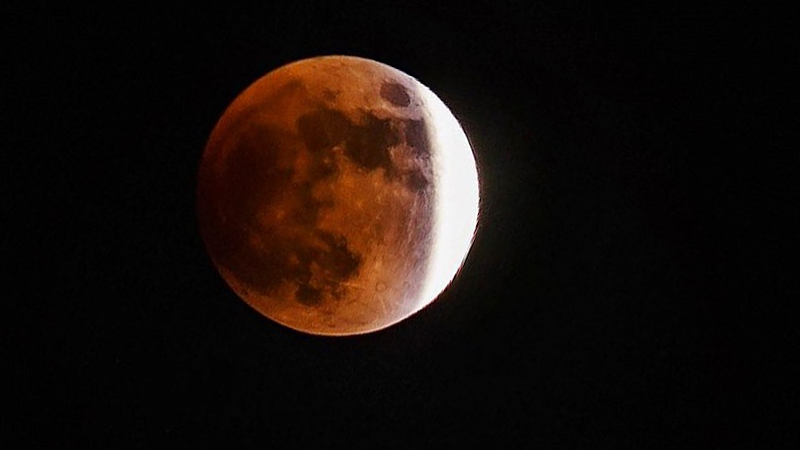
. , . , . , , , 15 .
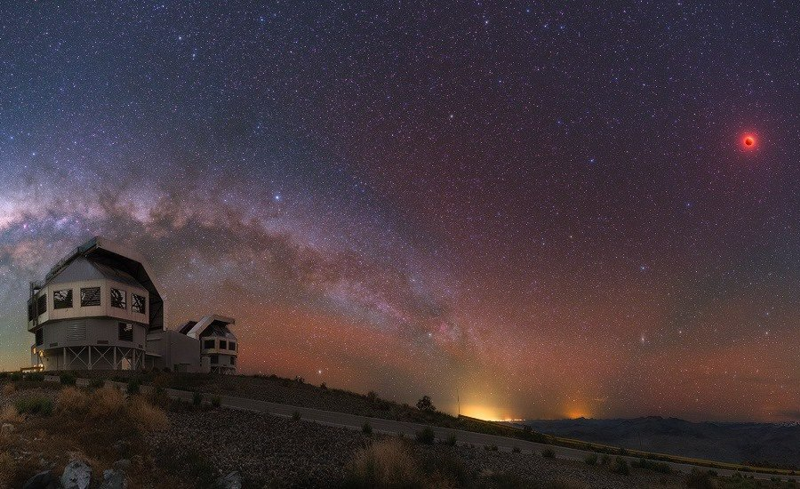
, , , .
( — ) . , , . , — . , , . 10- , 1 , , 100 . ? - ? ? , , ?

, , , . 100 , 1 , « » , . - , , . , , , — -, . , , , .
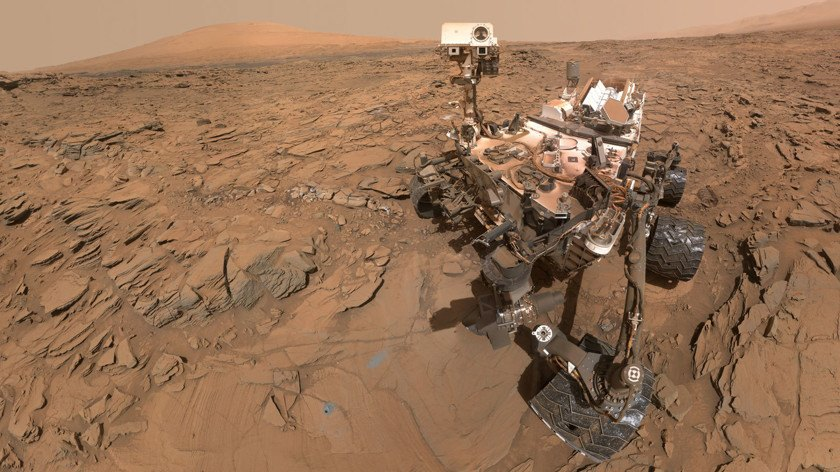
, , , , — — , ( ).
, , — , - — — -. 27 28 2018 .
, Stellaruim — - .
, .
UT —
MT —
NASA ( ):
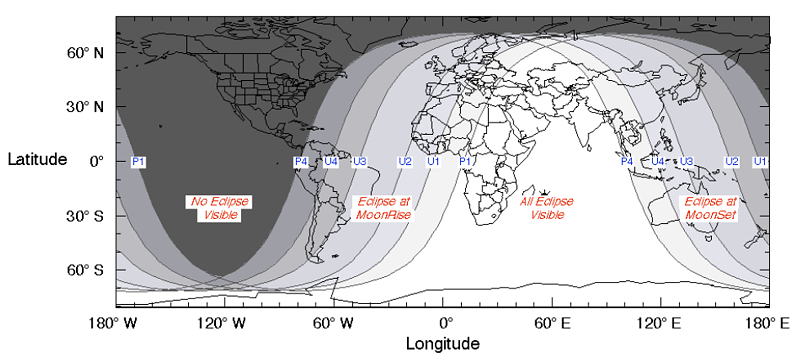
On the night of July 27-28, 2018 two rather rare astronomical phenomena will occur. The fact of their calendar coincidence does not make these phenomena more valuable for science, but creates additional interest around them. Some people consider the coincidence of two astronomical phenomena as a certain independent phenomenon, which is not quite correct, but deserves separate consideration from the point of view of understanding how often this happens, and whether the one affects the other in any way.

')
What will happen?
First appearance
On July 27, at about 7 am Moscow time, the great opposition of Mars will occur. Similar phenomena occur once every 15 or 17 years. The previous great confrontation took place on August 27, 2003, and since that time the virus fiction has been roaming the Internet, which has become more acute in August:
“On August 27, raise your eyes to the night sky. On this night, the planet Mars will pass only 34 thousand miles from Earth. It will look like two moons ... "
For 15 years, the epidemic has not subsided. As you can see, the great oppositions of Mars have a significant impact on ignorant minds.

The second phenomenon
On July 27, at around 8 pm, the half-shadow phases of a lunar eclipse will begin, during which the moon will completely plunge into the earth's shadow (the maximum immersion will occur at 23:22 Moscow time). Eclipse will end at 2 hours 29 minutes - already July 28. The phenomenon will last more than 6 hours. The moment of the great opposition of Mars, as we see, does not fall into the duration of the eclipse. But the temporary difference between the moment of opposition and the central phase of the eclipse is less than a day. Let it be a match criterion. It is quite enough that both events will occur (or at least begin) on the same calendar date.
For a start, let's deal with the essence of the phenomena themselves. What they are, what visual image corresponds to them, what physical or astronomical sense they have.
The great opposition of Mars
Wikipedia gives the following definition of the term “Confrontation”:
“Confrontation (opposition) is such a position of the celestial body of the Solar system, in which the difference of its ecliptic longitudes and the Sun is 180 °. Thus, this body is located approximately on the continuation of the “Sun-Earth” line and can be seen from the Earth approximately in the direction opposite to the Sun. Confrontation is possible only for the upper planets and other bodies that are farther from the Sun than the Earth. ”
This is exactly the case when the definition of a concept can lead to even more confusing, since it uses terms that require further clarification.
Ecliptic longitude:
“One of the coordinates in the ecliptic coordinate system; the angle measured along the ecliptic to the east, between the vernal equinox and the meridian passing through the heavenly body and the poles of the ecliptic. ”
Surdin VG, GAISH http://www.astronet.ru/db/msg/1162196
As we see, each following definition requires new definitions. And for a person who does not have the entire base of the basic concepts of astronomy, even the simplest astronomical phenomenon - the confrontation of Mars - can be very vague to understand.
Then maybe we will try to understand the essence of what is happening in some other, shorter way?
In the first approximation, the orbits of the planets are circles of different diameters. This degree of approximation doesn’t suit us very well, especially when the conversation concerns the planet Mars, but to start it will be enough. The orbits are located one inside the other concentrically. In the middle of this “drawing” is the Sun, and then in order of increasing the radius of the orbit - the planets: Mercury, Venus, Earth, Mars, Jupiter, Saturn, Uranus and Neptune. Pluto, if someone missed, since 2006, the big planet of the solar system is no longer considered.
Two planets from this list - Mercury and Venus - are internal. They are always closer to the Sun than the Earth (their orbits are located inside the Earth's orbit). The remaining five - Mars, Jupiter, Saturn, Uranus and Neptune - are external. They are always farther from the sun than the earth. And for these celestial bodies such situations are possible when the Earth, moving in an orbit, passes between the planet and the Sun. When viewed from Earth, the Sun and the planet turn out to be practically in opposite directions. The first consequence of this is that for a terrestrial observer, this planet and the Sun are not visible in the sky at the same time, and as soon as one star rises above the horizon, another immediately sets.

This arrangement of the outer planet is called opposition - the direction to it from the Earth is opposite to the direction to the Sun. The planet is in the sky all night. For her observations such a position is convenient.
The second consequence is that at the moment of confrontation (again, in the first approximation), the planet is closest to Earth. Because of this, it looks brighter (brightness, as is well known, is inversely proportional to the square of the distance), has large visible dimensions (with a telescope, of course, but this is not noticeable to our eyes). And this is also a positive circumstance for astronomical observations. Therefore, the confrontation of the planets is the best time to explore them from Earth. Astronomers have long tried to use days and weeks close to opposition to explore planets. People who have no relation to astronomy most often simply marvel at the appearance in the sky of star-shaped luminaries of extraordinary brightness, which they had not noticed before in the sky.
Note
For the sake of severity, it must be said that the appearance of unusually bright objects in the sky is not always connected with the planets entering into opposition with the Sun. For example, the planet Venus achieves the greatest brightness between the highest elongations and the lower junction, and causes frequent UFO reports. But our article is still about something else.
Now is the time to remember that in fact the orbits of the planets are not circles. About four centuries ago, Johann Kepler defined planetary orbits with ellipses. Orbits of some orbits are noticeably different from circular ones. Mars is particularly relevant. The value characterizing the elongation (difference from the circle) of an elliptical orbit in astronomy (and mathematics) is called eccentricity. Without going into the deep meaning of this concept, I will simply cite for comparison the eccentricities of the orbits of the planets of the solar system visible to the eye:
| Mercury | 0.20563593 |
| Venus | 0,0068 |
| Land | 0,01671123 |
| Mars | 0.0933941 |
| Jupiter | 0.048775 |
| Saturn | 0.055723219 |
An absolutely circular orbit has an eccentricity of zero. Those in the table there. The most significant eccentricity among the orbits of the major planets of the solar system, the orbit of Mercury - 0.2. But Mercury is an inner planet, and there is no opposition to Mercury. The second place in elongation is Mars orbit ~ 0.1. This is 6 times the eccentricity of the Earth's orbit, and we can easily consider the Earth's orbit as circular - to simplify the understanding of the difference in the mutual arrangements of Earth and Mars.
Such a noticeable elongation of the Martian orbit leads to the fact that in one Martian year (the period of Mars’s orbit around the Sun is about two Earth years), the distance from Mars to the Sun varies from 207 to 249 million km. As you can see, the difference, even on the cosmic scale of the solar system is noticeable - more than 40 million kilometers. Approximately with the same difference, the distances from Earth to Mars change during the confrontations. And if the opposition happens near the perihelion of the Martian orbit (perihelion is the nearest point of the planetary orbit to the Sun), then Mars and Earth are separated by less than 60 million kilometers. If the Earth and Mars are on the same straight line on one side of the Sun near the aphelion of the Martian orbit, then, despite the fact that this opposition, between the planets will be about a hundred million kilometers. Agree that 60 or 100 million is a huge difference for astronomical observations.

And indeed, all the most significant discoveries in astronomy related to the planet Mars, made with the help of telescopes, occurred during the "close" confrontations. And astronomers began to call the opposition, during which Mars and Earth are closer than 60 million kilometers from each other, great.


It was during the great confrontation of 1877 by the American astronomer Asaf Hall that two Mars satellites were discovered - Phobos and Deimos, which are essentially small asteroids of irregular shape, once gravitationally captured by Mars (according to one of the hypotheses); and the beginning of the so-called "Martian Fever", when Giovanni Schiaparelli saw, among other details of the surface of the planet, thin straight lines connecting the dark, called "seas", space. And although the existence of “Martian canals” was not confirmed later, every great opposition of Mars attracted astronomers to the telescope eyepieces, and science fiction writers tirelessly wrote thousands of pages, embodying their wildest assumptions about possible life on a planet similar to Earth.

Let us consider the conditions under which the Great confrontations occur. To do this, we need an acquaintance with another important astronomical value - heliocentric longitude. If you look at the solar system from its north pole (and it also has it, but we will not define this concept now - perhaps we will be able to deal with it and other astrometric terms in the next article). We will again see the concentric structure of the planetary orbits. Each planet is somehow located in its own orbit. The orbit itself is also somehow oriented in space. But we do not yet have a “point of support” in order to cling to something, and then count the coordinates in some units and determine the positions of the planets in such a simple drawing.
Historically, the reference point was the direction of the vernal equinox. See, the ray leaving the center of the Earth in the direction of the Sun at that moment, when on Earth the day is equal to night and the (astronomical) spring comes - this ray goes somewhere in the direction of the constellation Pisces. In fact, in the direction of that line, which is the intersection of the plane of the ecliptic and the celestial equator, but omit these details. It is important to us that the direction is somehow determined. Now, but relying on the center of the Sun, we can lay the angles between this and all other directions on the plane of our simplified scheme of the Solar System.

For example, we can measure how different are the directions to the vernal equinox and the point of the Martian orbit where it is closest to the Sun? - it turns out, at 336 degrees (in the counterclockwise direction, in which all the planets move around the Sun). This value is called the longitude of the perihelion. It is interesting to know on what day each year the Earth passes this point (with the same heliocentric longitude) of the orbit, above which the perihelion of Mars is located? After all, if a confrontation ever happens on that day, it will be a record close.
A happy “Martian day” falls on the very end of August - on August 28 or 29, depending on the year. Here is the time to recall the previous great opposition of Mars in 2003, which happened exactly on the aforementioned days of August (practically), and for its exclusivity, it was called the “greatest” opposition of Mars. Yes - nowadays simply you will not surprise anyone with the great opposition of Mars. But, really, then the Earth and Mars were separated by only 55.8 million km.
And what about the current great opposition? It is, alas, not so close and it could even be called “too big”, since the distance between Earth and Mars on July 27, 2018, and the days nearest to this date, will be 58 million kilometers, which is closer to the threshold, beyond which confrontations are no longer considered great, rather than to the “Greatest” confrontations.
Now it is interesting to recall one interesting clarification, which is expressed in the fact that if during the greatest confrontation of Mars, the day of confrontation and the day of maximum convergence of the Earth and Mars actually coincide, then for most of the other confrontations this is not the case. For example, this year the opposition of Mars, when in the celestial sphere it will confront the Sun, will happen on the morning of July 27, but due to the ellipticity of the orbit, Mars will be closest to Earth on the night of July 31 to August 1.
The second interesting clarification is that the position of the perihelion of the Martian orbit changes with time. For a thousand years, the angle between the direction of the vernal equinox and the perihelion of Mars increases by more than 4 degrees. And that period on the calendar grid, in which great confrontations can happen, will shift 4 days ahead in a thousand years.
Now great confrontations can occur between July 24 and October 2. In the future, these dates will change slightly. In the past, they were also slightly different. Although it is not so important now.
How often happen the great opposition of Mars?
Since the criterion by which Mars’s oppositions are defined as “great” is very conditional, it’s difficult to talk about some unequivocal calculation of these events at a considerable distance from the present moment into the past or the future. Simply put, the great oppositions of Mars occur every 15 or 17 years with a rather confusing alternation of time intervals separating them. As an example, confrontations from a century and a half ago in the present era can be cited:
| September 19, 1830 | 15 years |
| August 18, 1845 | 15 years |
| July 17, 1860 | 17 years |
| September 5, 1877 | 15 years |
| August 4, 1892 | 17 years |
| September 24, 1909 | 15 years |
| August 23, 1924 | 17 years |
| July 23, 1939 | 17 years |
| September 10, 1956 | 15 years |
| August 10, 1971 | 17 years |
| September 22, 1988 | 15 years |
| August 28, 2003 | 15 years |
| July 27, 2018 | 17 years |
| September 15, 2035 | 15 years |
| August 13, 2050 | ? |
Such tables can be easily found on dozens or hundreds of sites on the Internet. But then the interesting begins. The confrontation of July 13, 2065 is formally a little short of a great one, since at the very moment of the confrontation Mars and Earth will be separated by a distance of 60.191 million km - it would seem - a trifle, and does not pass under the criterion. But - on the evening of July 18 - having already passed the confrontation - Mars will come closer to Earth to 59.790 million km. And here it is already difficult for him to deny greatness, since all the days surrounding the confrontation itself are considered an era of confrontation. Two years later, another great confrontation will happen - on October 3, 2067, when Mars will be just a little closer, but also completely below the bar - 59.94 million km at the time of opposition, and - 59.34 million km with maximum convergence five days earlier. And no one knows how the astronomical public will relate to the classification of these phenomena in almost half a century from today. Moreover, if we consider the opposition carefully, it is clear that the sum of the distances separating the Earth and Mars (60.19 + 59.94 = 120.13) exceeds 120 million kilometers for two, which means that it is theoretically possible that after 15 years no great confrontation will happen in the next two years, judging them strictly. And then another 15 years Mars will be objectively far to correct this state of affairs.
Why has this situation never happened in the past?
It may have arisen, but did not fall into the attention of astronomers of past centuries, since the phenomenon itself - “the great opposition of Mars” - was introduced only when it became possible to accurately determine the distances to the planets, that is, relatively recently.
Why, in some confrontations, Mars shines with a surprisingly bright luminary, and in others - only an ordinary reddish "star" - neither ancient astronomers, nor contemporaries of Galileo - did not know this. And even in the era of the invention of the telescope, among serious astronomers there were many supporters of the theories about crystal spheres and ideal circles instead of elliptic orbits.
And how much different are the visual characteristics of Mars from opposition to opposition?
First of all, the brightness of the planet is very different. Between the oppositions, when Mars is lost in the evening or morning dawn, its brilliance is comparable to the brightness of one of the stars of the Ursa dipper and no one pays attention to it. During distant confrontations, when the Earth and Mars are separated by hundreds of millions of kilometers, Mars is noticeably brighter, and already successfully competes with the brightest stars of the sky. His characteristic magnitude is -1m. That is, it is brighter than most stars, but weaker than Sirius (Big Dog's alpha is the brightest star in the sky). But during the great confrontation, Mas's brilliance reaches -2.9m, and then Mars becomes the brightest star of the earth after the Sun, the Moon and Venus. And if you consider that neither the Sun nor Venus does not shine at night, then during the great opposition of Mars only the Moon can shine brighter in the sky than it. But even under the Moon, Mars draws its attention with its distinctly red hue completely uncompromisingly, since none of the bright stars have such a saturated red color ... Is the Moon in eclipse ...

Comparison of the apparent size of Mars at different distances from the Earth
Comparison of the apparent size of Mars at different distances from the Earth (when observed through a telescope):
- left image - during the great confrontation
- medium - during normal standoff
- right - near the top connection to the Sun, at the greatest distance from the Earth.
And here we remember that the upcoming July 27, 2018 great opposition of Mars will occur on the same date with a total lunar eclipse - no less outstanding than the opposition of Mars.
Let's talk a little about eclipse now.
Even 10 years ago, it seemed to me that it was not necessary to explain the nature of such phenomena, and they all more or less clearly imagine what caused the eclipses to happen - that celestial bodies cast shadows. And either an observer (a case characteristic of a solar eclipse) or another celestial body (this is just a lunar eclipse) can fall into the shadow of a celestial body. I understand that among the readers of this article such basics are probably known, but it is necessary to at least briefly designate them, because from these elementary points there are consequences, questions, interesting details.
It is not difficult to guess that lunar eclipses — phenomena of transit of the moon through the earth's shadow — occur only when the moon in the sky is opposite to the sun, that is, on a full moon. At the same time, not every full moon is accompanied by a lunar eclipse. The lunar orbit lies in a plane different from that of the earth’s orbit, and most often the moon passes under a shadow or above a shadow. And the shadow falls on average a couple of times a year. And this is not necessarily exactly when it is above the horizon. Quite often it happens that the moon eclipse happens when we have all day long. Or - in bad weather. So, to get on this heavenly show - a rare luck and great honor for any person interested in astronomy - to see how slowly the Moon disappears in a dark roundish shroud, how it is littered, acquiring a deep red tint completely unusual for it, how its night shine fades, yielding to the radiance of the stars and the Milky Way ... how everything returns back, leaving only amazing sensations of belonging to something rare and special. It is not surprising that our ancient ancestors gave eclipses such a significant meaning, not always corresponding to their true nature, but always emphasizing the originality of the event.
As you might guess, there are only two points in the lunar orbit, next to which the moon can "meet" with the shadow of the Earth - these are the so-called lunar nodes. And it may seem that in the year there are two calendar dates, near which eclipses can occur. But in fact, the lunar nodes do not stand still and slowly turn, "running" all the ecliptic for 19 years. To this are added light rocking - changing the angle of inclination of the lunar orbit with respect to the Earth. In combination of the described and many other factors lies the non-triviality of predicting the moments and circumstances of lunar eclipses, which, at least in terms of visual characteristics, are quite different.
We list the main differences between the phenomena falling under the classification "lunar eclipse"

The moon is four times smaller than the Earth, therefore, it should fit in the earth's shadow. But then the Earth is smaller than the Sun, and therefore it casts a converging cone of shadow into space. At a distance of a few more than a million kilometers from Earth, the earth’s shadow is finally fading away. But since the Moon is at an average distance of 384 thousand km from the Earth, it is quite able to plunge into the shadow, and at such a distance the cross section of the shadow is more than twice the diameter of the Moon.
The Earth casts in the direction opposite to the Sun not only a conically decreasing shadow, but also a conically expanding penumbra. If the observer is in the penumbra, then he sees the solar disk, slightly obscured by the body of the Earth - an analogue of a partial solar eclipse, which occur on the Earth due to a similar "fault" of the Moon.
And any shadow lunar eclipse is preceded by a half-shadow phase - to get to the earth's shadow, the moon will have to overcome half-shadow and darken a little in it. But the fall in the brightness of the lunar disk, crossing the Earth's partial shade, is almost imperceptible to the eye.
If the full moon comes at some distance from the node of the lunar orbit, the moon can pass by the shadow, but fall into penumbra. Such eclipses are called penumbral. As a rule, they do not receive the attention of a public who is far from science. Even lovers of astronomy do not attach much importance to them. But if the Moon is even a little bit in the shadow, then this is already a shadow eclipse, and everyone who has such an opportunity is watching it. And again, the moon may not fully sink into the shadow, and soon leave it. Then it is a private shadow lunar eclipse.

The upcoming eclipse is a complete one. Moreover, it is almost central. The center of the moon will pass less than a quarter of a degree to the north (above) of the center of the earth's shadow, but at the same time the southern continental part of the lunar disk, having a maximum brightness outside the eclipse, will fall into the center of the shadow. Because of this, a general drop in the brightness of the moon will be the maximum possible (other things being equal). The upcoming lunar eclipse will turn out to be one of the darkest eclipses, which undoubtedly makes it unique, and for science its observation can bring a lot of useful data about the Earth's atmosphere.

During total lunar eclipses - even the darkest - the moon does not disappear in the sky at all. But its appearance is changing. Instead of a bright white-yellow disk shining in the night, only dark-red remains in the sky - sometimes, barely noticeable - an obscure ghost of the Moon. How does sunlight reach the moon if it is completely submerged in the earth's shadow?

During an eclipse, the Moon is shielded by the body of the Earth only from direct sunlight, but not from refracted and scattered by the Earth's atmosphere. Of the entire spectrum of visible rays of the moon, only the longest wavelengths — red and orange rays — reach. The rest are absorbed by the earth's atmosphere. By conducting photometric and spectral observations of the eclipsed moon, astronomers can get quite a lot of information about the processes occurring in the Earth’s atmosphere. , , , , — , , .
, ( — ) : , () . , 27 — — , . ( , — , — .) 6 . , 58 , .
?
, , . , — 15 — 17 . , ?
, . — — ? . — — .
, , , . , , — 15 17 . — 32 . — “ ” ~ 19 . 608 . , , . , , . , , . — , — — 27 2018 .
, .
, () . , , . . 65 , . , , .
«» , . . , .
, , ISO. , . ISO , , , . ISO 100. , , ISO 200, 400, 800 . , , .
10 — , , , , . , , , . — , . , — . , . , . « ».

?
, ISO 100 10 1/100 . , , , 1/160 — 1/200 . 27 28 . 15 . , 1/100 — 1/60. . , . , , 2- , .
, . , ( — ), , — , , .

. , . , . , , , 15 .

, , , .
( — ) . , , . , — . , , . 10- , 1 , , 100 . ? - ? ? , , ?

, , , . 100 , 1 , « » , . - , , . , , , — -, . , , , .

, , , , — — , ( ).
, , — , - — — -. 27 28 2018 .
, Stellaruim — - .
, .
Good luck!
Application:
| UT | MT | Note | |
|---|---|---|---|
| 18:24 | 21:24 | ||
| — | 19:30 | 22:30 | - - |
| — | 20:22 | 23:22 | , , , |
| — | 21:13 | 00:13 | |
| 22:19 | 01:19 | — , , — . | |
| 23:29 | 02:29 |
UT —
MT —
NASA ( ):

Source: https://habr.com/ru/post/417741/
All Articles